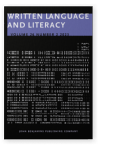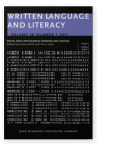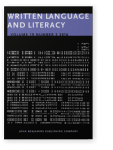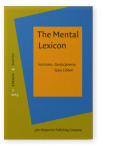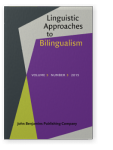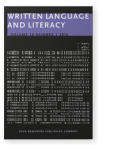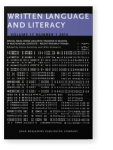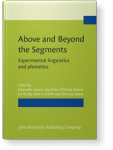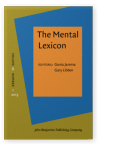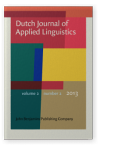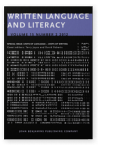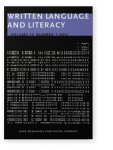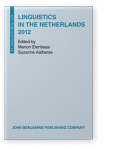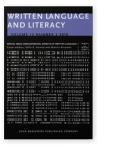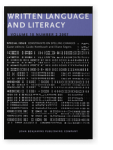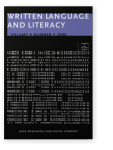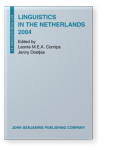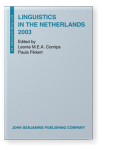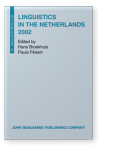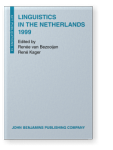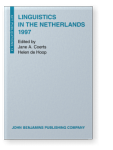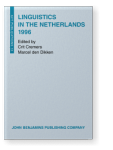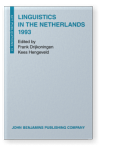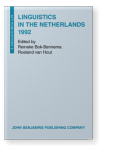Anneke Neijt
List of John Benjamins publications for which Anneke Neijt plays a role.
Journal
2017 The BasisSpellingBank: A spelling database with knowledge stored as a lexicon of triplets Orthographic Databases and Lexicons, Cahill, Lynne and Terry Joyce (eds.), pp. 52–79 | Article
The BasisSpellingBank is the first lexicon where the spellings and pronunciations of words are documented explicitly and separately for all relevant word parts. Unlike earlier descriptions of Dutch orthography in terms of rules and underlying forms, the BasisSpellingBank departs from the concept… read more
2016 SHOTGUN: converting words into triplets: A hybrid approach to grapheme-phoneme conversion in Dutch Written Language & Literacy 19:2, pp. 157–188 | Article
Software systems convert between graphemes and phonemes using lexicon-based, rule-based or data-driven techniques. SHOTGUN combines these techniques in a hybrid system which converts between graphemes and phonemes bi-directionally, adds linguistic and educational information about the… read more
2015 Regional origin affects the interpretation of linking elements in spoken Dutch compounds The Mental Lexicon 10:2, pp. 165–185 | Article
In Dutch, the linking element en in compounds is often homophonous with the regular plural suffix -en. Both are pronounced as [ә], [әn] or [ṇ] in different regions of the Netherlands. As a consequence, speakers of standard Dutch may interpret linking en in spoken compounds as a plural marker. The… read more
2015
In standard Dutch, the plural suffix -en is homographic and homophonic with the linking suffix -en (boek+en “books”, boek+en+kast “bookcase”), both being pronounced as schwa. In Frisian, there is neither homography nor homophony (boek+en “books”, pronounced with syllabic nasal; boek+e+kast… read more
2015 From t-bias to d-bias in Dutch: Evidence from children’s spelling and pronunciation Written Language & Literacy 18:1, pp. 104–120 | Article
Previous studies reveal that young Dutch children display a [t]-bias in the middle of words in pronunciation (e.g. van der Feest 2007; Kerkhoff 2007). First graders, however, display a 〈d〉-bias in the middle of words in their writings (Neijt & Schreuder 2007). The present study investigates… read more
2014 In memoriam Robert Schreuder Cross-linguistic transfer in reading in multilingual contexts – recent research trends, Zaretsky, Elena and Mila Schwartz (eds.), pp. 171–172 | Miscellaneous
2014 Etymological sub-lexicons constrain the graphematic solution space Above and Beyond the Segments: Experimental linguistics and phonetics, Caspers, Johanneke, Yiya Chen, Willemijn Heeren, Jos Pacilly, Niels O. Schiller and Ellen van Zanten (eds.), pp. 189–202 | Article
Graphematics comprises of the theory of writing systems dissociated from the
normative aspects of orthography. Neef (2005, 2012) adds the notion of graphematic
solution space, the orthographic options available for the words in a
language. These options may be different for the words of different… read more
2013 Plurals as modifiers in Dutch and English noun-noun compounds express plurality in production The Mental Lexicon 8:1, pp. 53–74 | Article
The present study investigates the relation between conceptual plurality and the occurrence of a plural morpheme in novel Dutch and English noun-noun compounds. Using a picture-naming task, we compared the naming responses of native Dutch speakers and native English speakers to pictures depicting… read more
2013 Zij surfde, maar hij durfte niet: De spellingproblematiek van de zwakke verleden tijd in Nederland en Vlaanderen Dutch Journal of Applied Linguistics 2:2, pp. 133–151 | Article
Hoewel de spelling van Nederlandse verledentijdsvormen van zwakke werkwoorden algemeen als eenvoudig wordt beschouwd (ze zijn immers klankzuiver) maken zelfs universiteitsstudenten opvallend veel fouten bij de keuze tussen de uitgangen -te en -de. Voor een deel zijn die fouten ‘natuurlijk’ in die… read more
2012 How subtle differences in orthography influence conceptual interpretation Units of Language – Units of Writing, Joyce, Terry and David Roberts (eds.), pp. 185–208 | Article
The present study investigates linguistic relativity. The units of writing investigated are e and en, which are used to represent units of language in Dutch, Frisian, and Afrikaans. Dutch has homographic forms in the plural suffix -en and the linking element of noun-noun compounds en. Frisian does… read more
2012 The 12321 model of Dutch spelling acquisition Linguistics in the Netherlands 2012, Elenbaas, Marion and Suzanne Aalberse (eds.), pp. 111–122 | Article
We propose that Dutch children acquire and use knowledge of Dutch spelling through a series of stages we call the 12321 model. At first, a single phase for the mapping of speech onto writing suffices, but in later stages of instruction, two or three mapping phases are needed. This is one aspect of… read more
2010 Review of Joshi & Aaron (2006): Handbook of orthography and literacy Developmental aspects of written language, Vernon Carter, Sofía A. and Mónica Alvarado (eds.), pp. 275–277 | Review
2007 The influence of spelling conventions on perceived plurality in compounds: A comparison of Afrikaans and Dutch Constraints on Spelling Changes, Nottbusch, Guido and Eliane Segers (eds.), pp. 185–194 | Article
Dutch compounds with ‘e’ or ‘en’ as linking element between modifier and head were presented to mother tongue speakers of Afrikaans in an experimental setting that explored the possibility that these different spelling formats would suggest a singular or plural meaning of the modifier. The… read more
2007 Asymmetrical phoneme–grapheme mapping of coronal plosives in Dutch Constraints on Spelling Changes, Nottbusch, Guido and Eliane Segers (eds.), pp. 219–234 | Article
The distinction between deep and shallow orthographies is a central issue in studies of alphabetic writing. This paper aims to contribute to the debate on the relative merits of these by investigating how the coronal plosives [d] and [t] map onto the corresponding letters d and t. It turns out that… read more
2006 Formal and semantic constraints on the interpretation of the suffix ‑s in reading Dutch nominal compounds Written Language & Literacy 9:2, pp. 247–264 | Article
This study addresses the interpretation of a Dutch homonymic suffix, s, as it appears in Dutch compounds. In a series of reading experiments we manipulated the presence versus absence of this suffix in existing compounds as well as in compounds with a pseudoword as left constituent. We observed an… read more
2004 Seven years later: The effect of spelling on interpretation Linguistics in the Netherlands 2004, Cornips, Leonie and Jenny Doetjes (eds.), pp. 134–145 | Article
2003 Verpleegsters, ambassadrices and masseuses: Stratum differences in the comprehension of Dutch words with feminine agent suffixes Linguistics in the Netherlands 2003, Cornips, Leonie and Paula Fikkert (eds.), pp. 117–127 | Article
2002 Rhythm and semantics in the selection of linking elements Linguistics in the Netherlands 2002, Broekhuis, Hans and Paula Fikkert (eds.), pp. 117–127 | Article
1999 The Structure of Rhythm Linguistics in the Netherlands 1999, Bezooijen, Renée van and René Kager (eds.), pp. 149–161 | Article
1997 Rules and Exceptions in the Spelling of Loan Words in Dutch Linguistics in the Netherlands 1997, Coerts, Jane A. and Helen de Hoop (eds.), pp. 147–157 | Article
1996 Dutch orthography: A near-optimal phonological transcription? Linguistics in the Netherlands 1996, Cremers, Crit and Marcel den Dikken (eds.), pp. 195–206 | Article
1993 Stress shift in Dutch hexameters Linguistics in the Netherlands 1993, Drijkoningen, Frank and Kees Hengeveld (eds.), pp. 93–104 | Article
1992 Rules and exceptions in Dutch word stress Linguistics in the Netherlands 1992, Bok-Bennema, Reineke and Roeland van Hout (eds.), pp. 185–196 | Article
